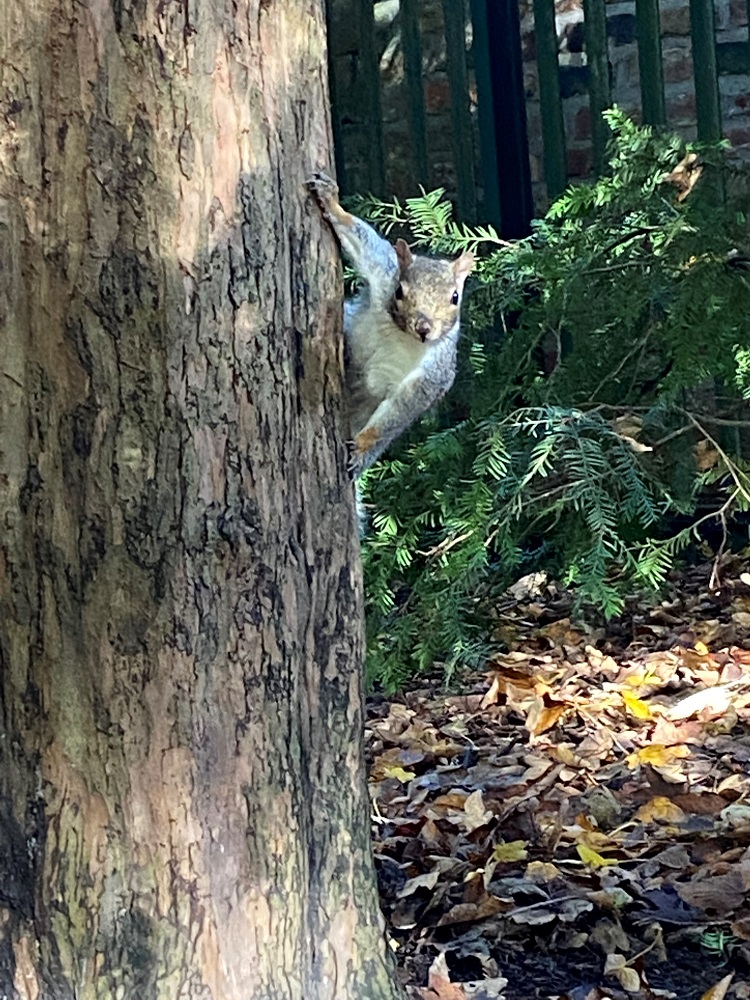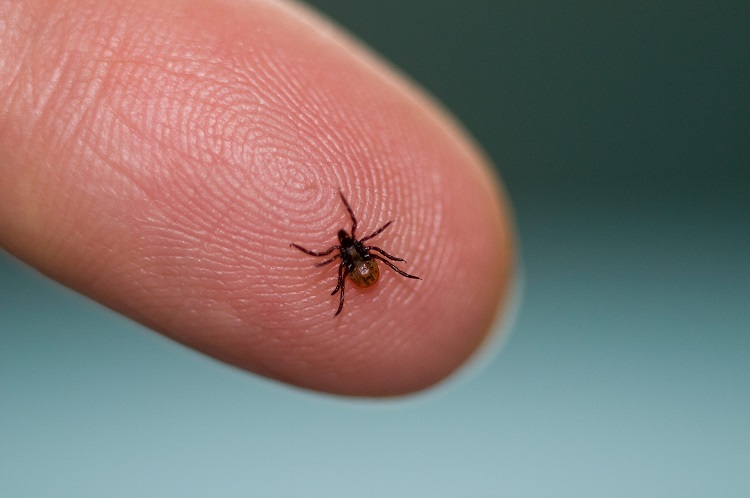A team from the Natural Resources Institute (NRI) has won a prestigious research grant from the UK Research and Innovation and Department for Environment, Food and Rural Affairs programme: ‘One Health approach to vector-borne diseases’. The aims of the research programme are to forecast, mitigate and avoid vector-borne diseases that threaten the UK, such as Lyme disease which is transmitted by ticks. The scientists aim to discover if grey squirrels, which carry young ticks – the ones most responsible for Lyme disease transmission to humans - can be sustainably managed by using contraceptive baits to lower the population.
 This joint UKRI-DEFRA programme has awarded £1.25 million to a multidisciplinary team that will research vector-borne diseases within a One Health framework, which considers the interconnections between the health of people, animals and ecosystems. The main objective of the project is to produce evidence-based recommendations for minimizing risks of tick-borne disease which could occur through rewilding and reforestation.
This joint UKRI-DEFRA programme has awarded £1.25 million to a multidisciplinary team that will research vector-borne diseases within a One Health framework, which considers the interconnections between the health of people, animals and ecosystems. The main objective of the project is to produce evidence-based recommendations for minimizing risks of tick-borne disease which could occur through rewilding and reforestation.
The UK's Net Zero 2050 policy contains bold plans to plant millions of trees each year to expand landcover in woodlands and forests, not only helping to sequester carbon but also helping to lower local temperatures as the climate changes. Such activities should be welcomed; however, changes in land use may have implications for the spread of unwanted non-native species and disease. Therefore, these plans must be evaluated to develop a robust strategy and avoid unintended consequences from the interventions.
The NRI-led project: ‘One Health approach to tick-borne disease control through manipulation of reservoir host communities at landscape scale’, is headed by Professor Steven Belmain and Dr Dan Bray at the Natural Resources Institute, University of Greenwich and involves a co-investigator team of research colleagues based at the University of Salford (Prof Richard Birtles), the University of York (Dr Giovanna Massei), the Animal and Plant Health Agency (Dr Simon Croft) and Forest Research (Dr Harry Marshall).
The project will focus on Lyme disease. Caused by a bacterial infection, early symptoms of Lyme disease include a rash, fever and pain, and the infection can affect the nervous system if left untreated. Lyme disease is well established in the north-eastern parts of the United States, and incidence is growing in the UK and across many parts of Europe.
the infection can affect the nervous system if left untreated. Lyme disease is well established in the north-eastern parts of the United States, and incidence is growing in the UK and across many parts of Europe.
People acquire the disease from the bite of infected ticks searching for a blood meal. Ticks blood feed on a range of wild animals but will also feed on humans walking through their countryside and woodland habitat. Ticks don’t fly, so wait for animals to walk by, jumping on to anything that disturbs the vegetation they are waiting on. Adult ticks often feed on deer, but younger stages usually feed on smaller animals, particularly rodents. It is these immature stages of ticks that are the most dangerous in terms of Lyme disease transmission to humans.
 Grey squirrels are one of the most common small animals present in woodland and are host to both ticks and Lyme disease. The grey squirrel is an invasive species in the UK which displaces the native red squirrel and costs the economy £37 million per year by bark stripping trees. Efforts to protect red squirrel populations by controlling grey squirrels are under way in many parts of the UK and have wide public support.
Grey squirrels are one of the most common small animals present in woodland and are host to both ticks and Lyme disease. The grey squirrel is an invasive species in the UK which displaces the native red squirrel and costs the economy £37 million per year by bark stripping trees. Efforts to protect red squirrel populations by controlling grey squirrels are under way in many parts of the UK and have wide public support.
Some experts have argued that the removal of grey squirrels by itself could result in a reduction in Lyme disease risk, but this has not yet been proven. This is because ticks can feed on other wild animals and it is not clear what will happen when grey squirrels are removed in terms of disease risk. Our project plans to answer this question by determining what happens when grey squirrel populations are being reduced, and how this affects ticks and diseases. We will also develop models to predict what could happen to grey squirrel populations, and the ticks and diseases they host, as a consequence of increasing woodlands and forests in the UK while the climate is also changing.
Prof Belmain explains: “Our research aims to build on these ongoing activities to control grey squirrels, helping to understand the role of greys in perpetuating Lyme disease and seeing whether reducing the population of greys can also reduce the prevalence of ticks and Lyme disease. We hope to show that grey squirrels can be sustainably managed in humane ways by using contraceptive baits that will lower their population, helping the smaller red squirrel population to recover and expand so that more people can appreciate reds in the wild whilst reducing the chances of catching Lyme disease.”
Dr Bray’s role in this project is to explore the possibility of using chemical attractants and repellents to prevent ticks finding animals on which to feed and thereby reduce the transmission of Lyme disease. Ticks smell by using special sensors on their front feet, but not much is known about the chemicals which they use to find their hosts. Dr Bray says: “This exciting project brings together experts in different aspects of mammal, forest and tick biology, aiming to reduce risk of Lyme disease. The One Health approach we have adopted is applicable to many vector-borne diseases threatening animal and human health.”
The team will engage with the public throughout the project, particularly with groups trying to save the red squirrel through grey squirrel control. The project team will also explore the attitudes of the wider public and their attitudes towards squirrels, ticks and infections such as Lyme disease. This is an essential step toward understanding people's concerns about animal control, and how best to protect people from vector-borne disease in a changing environment and climate.
Watch Professor Belmain on KMTV (at 38 minutes into the programme)
To find out more about:
The Animal and Plant Health Agency
The Animal and Plant Health Agency (APHA) works across Great Britain to safeguard animal and plant health for the benefit of people, the environment and the economy. www.gov.uk/apha @APHAgovuk
Forest Research is Great Britain’s principal organisation for forestry and tree-related research and is internationally renowned for the provision of evidence and scientific services in support of sustainable forestry. www.forestresearch.gov.uk @Forest_Research
The Environment Research and Innovation Centre at the University of Salford delivers applied and impactful environmental research and innovation necessary to understand global challenges and develop solutions for industry, government, and wider society. Our studies of past and present environments, coupled with our development of novel approaches for quantifying and managing environmental change, support sustainable development from the local to the global scale. https://www.salford.ac.uk/ @SalfordUni
The University of York is a member of the prestigious Russell Group of research-intensive universities. Academic staff work collaboratively in partnership with institutions across the world to develop life-saving discoveries and new technologies that tackle some of the most pressing global challenges. www.york.ac.uk/@UniOfYork
The University of York hosts the Europe office of the Botstiber Institute for Wildlife Fertility Control, dedicated to raising awareness about contexts in which fertility control can be applied. https://wildlifefertilitycontrol.org/

